| Please access the following URL if you want to secure using SSL. All pages in the site will be secure pages. |
| https://secure02.blue.shared-server.net/www.fish-food.co.jp/message english 3.2019.html |
Welcome to FISH FOOD TIMES
Mar. 2019 issue No.183

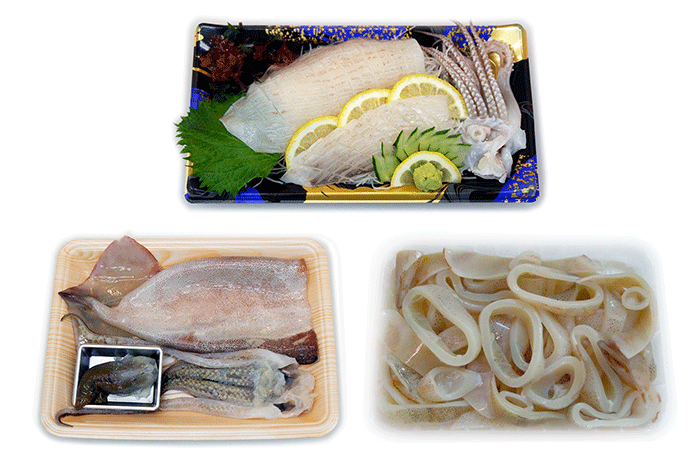
Delicious Japanese Common Squid···
Japanese Common Squid poor catch is followed
In 2018, the nationwide landing capacity of Japanese Common Squid became 41,697 tons, down 23% from 2017 which was the worst poor catch in history, and it was decided to reprint the lowest record ever.
Looking back at the catch of Japanese Common Squid in the past, it increases and decreases repeatedly in a large cycle as follows.
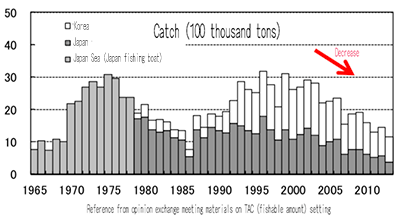
Twenty-two species of Japanese Common Squids have been confirmed, with the highest catch in the squid, with distribution and migration along the continental shelf. It is characterized by a single breeding only once in a lifetime, and finishes its lifetime with only one breeding.
The characteristic of Japanese Common Squid is that the egg-laying group through the four seasons mainly exists in the autumn generative group and the winter generation group as shown in the following figure, and the largest spawning grounds (Southwestern Sea of Japan Sea - East China Sea ), When will the temperature suitable for egg laying, it determines the seasonal occurrence group rise and fall.
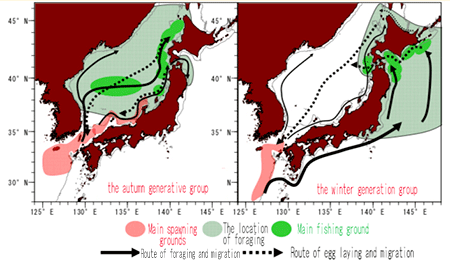
Children of Japanese Common Squid born in the Tsushima Sea area and in the East China Sea ride north above the warm current. Forging · During the growth period, it grows in the Sea of Japan Sea, where the sea temperature is 13 to 15 ° C, and in the subarctic waters where there are many large zooplankton, which are low in water temperature such as the northern Japan Sea. And after the autumn grew bigger and began south, male ripened in high water temperature areas, and intercourse acts on females that are still mature. Then, the female migrates further to the egg-laying area where the water temperature is higher, becomes ripe state in the course of it, spawns, dies and ends a brief one-year lifetime.
There is an academic paper called 'Reproduction Hypothesis' of Japanese Common Squid that Professor Yasunori Sakurai of Hokkaido University Graduate School of Fisheries Science has reached over 30 years. It is "Japanese Common Squid hatchery larvae can survive the most spawning sea area from the continental shelf depth of 100 m to 500 m in the surface warm water on the continental shelf slope, its water temperature range is 18 to 24 ° C., especially 19.5 to 23 ° C. "
There is "regime shift theory" which is closely related to the water temperature. This is a story by Professor Ken Kawasaki of Tohoku University announced in 1985 the idea of "regime shift (conversion of basic structure)". This is a hypothesis that "the number of fish periodically fluctuates because the climate and marine environment change in units of decades." Variations in the atmosphere and the ocean are closely related to each other, but factors that compose the climate such as temperature and seawater temperature rapidly change after sustaining over a long period of time. The marine ecosystem will change depending on the influence, but representative examples are fish species change phenomenon such as Japanese Common Squid and sardine.
As shown in the figure below, when charting changes over a long period, we see that regime shifts occur in decades. And the period when the era changed from 1988 to 1989 to Heisei was called "1988/89 regime shift", it was considered to be the year that shifted from the cold regime to the temperate regime, and in the winter after 1989 a cold seasonal wind continues with no momentum.
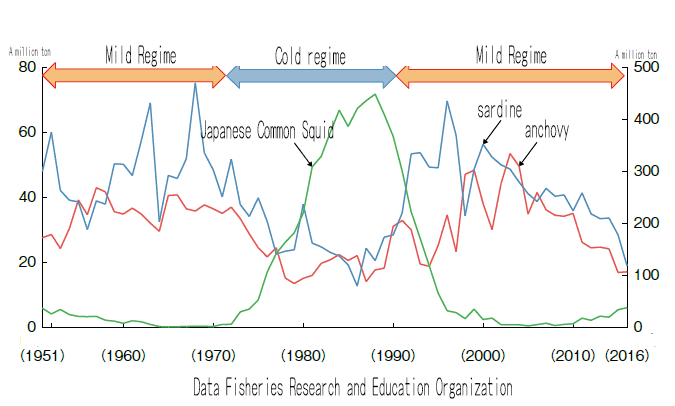
As also shown in this graph, for about 20 years from 1970 to the end of the 1980s, the Aleutian low pressure developed and the winter seasonal wind of the northwest continued for a long time, so this period was a cold regime period is called. In this season the rean cold flow is strong in the Japan Sea and the cold water area extends to the Tsushima Strait, the autumn-born group of Japanese Common Squid concentrates on the San'in Coast and the spawning grounds on the East China Sea shelf slope of the winterborn group are Chinese cold water the spawning ground was interrupted, Japanese Common Squid born in the winter group drastically decreased, and the fishing season of the autumn-born group shorter. In this way, if the spawning grounds shrinking and the continuity of the seasonal spawning ground are interrupted, the resources of Japanese Common Squid are going to decline.
When thinking about fluctuations in squid stocks, since generation changes of squid are one year unit, relationship between parent and child is clear. There is a correlation that there are many children if there are many parents, and vice versa, and if there is excessive catch of parent squid in the process of reproduction, the resources of the next year will be drastically reduced immediately. It is also affected by fluctuations of long-lived fish resources such as mackerel and sardines competing for food.
There is something I want you to pay particular attention to in the graph above. That is that the catch of sardine draws a curve exactly opposite to Japanese Common Squid.
In the past, No.142 All of Sardine (Sashimi & Sushi) In the October issue of Heisei 20, articles were reported that recently catch of sardine has increased. That trend has been increasing steadily since then, as you already know that the presence of sardines is increasing. The facts are shown in the following graph in outstanding form.
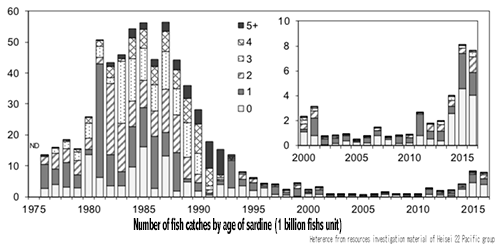
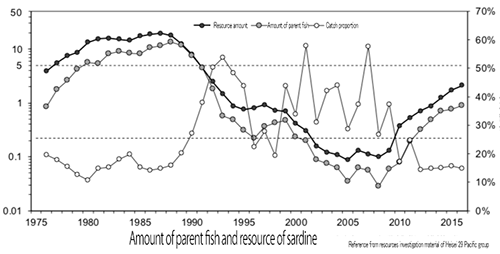
One of the rigid facts that occurred in the midst of the changes in the marine environment for 20 years since the 1970s is that "squid will decrease and sardines will increase when entering cold regime". One fact that can be inferred from this phenomenon is that "it is already in the cold regime period in 2019".
For example, the signs of the cold regime period are also evident in the change of the earth's seawater temperature, and the weather expert Joe Bastardi said inNoTricksZone that the world occurred in the past three years in 2015 and 2018 The data of the seawater temperature inside is shown in the figure below.

This is expressed by Mr. Jo Bastardi as "pretty dramatic turnaround", that is, for this 4 to 5 years, this shows the fact that "the temperature of the earth's seawater continues to drop down" .
Also, Japanese blogger Kirie@KiryeNet contrary to warning such as ICPP that Arctic sea ice has disappeared, now the Arctic sea ice amount (m 3) level shows a recovery trend in the past 10 years, now The Arctic sea ice volume has been at the fourth highest level in the past 16 years since 2003, and the spread of the Arctic sea ice is far beyond the level of the past several years, the following graph at twitter posted and sent.
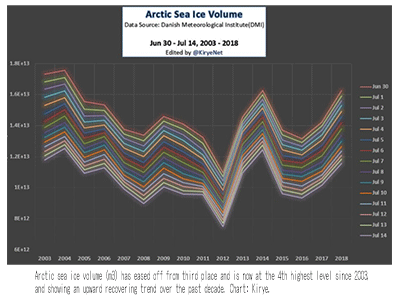
In other words, from these global meteorological facts mentioned above, what is inferred in terms of fisheries catch in the future is that Japanese Common Squid will not increase in landing at the present moment and this earlier time when catch of sardine is good It is predicted.
Those who are made a product made from Japanese Common Squid as a raw material in a family business or a company, I think that I am sincerely wishing that Japanese Common Squid fishery would be recovered. However, unfortunately, it seems that it should be thought that it is not expected that catch of Japanese Common Squid which is sudden at the moment is expected. Also, people who are retailing Japanese Common Squid should also be ready to sell Japanese Common Squid at a cheap price like the old days is basically difficult.
Commercialization of Japanese Common Squid
Well then, how do people who retail fish sell Japanese Common Squid as cheap as before? It will not be a simple form of packing in a tray as it is, but selling it as it is, but by raising the value as a product, we will have to strengthen the shape that will satisfy our customers.
The following left image is Japanese Common Squid with 25 freshness with outstanding freshness that only a few hours have passed since it was brought to the store from the fishing port, with transparency remaining. And the image on the bottom right has been several days, and after the black color on the surface became brown, it is a raw 20 Common Squid that is turning white as the last stage of discoloration.

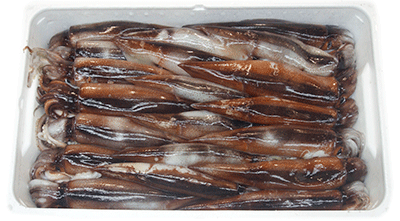
Let's start commercializing Japanese Common Squid entering 20 fishs from here.
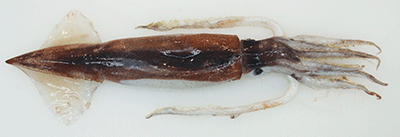 surface
surface
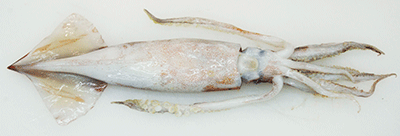 Back
Back
First of all it is a commercialization process of round slice for boiled and geso for frying.
| Slice for boiled | Geso for frying | |
|---|---|---|
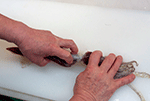 |
 |
|
| 1,Put your left finger at the end of the body and pull geso with your right hand | 1,Cut along the top of the cuttlebone vertically | |
 |
 |
|
| 2,While attaching the liver to geso, pull out so as not to break | 2,Open from the cut of kitchen knife | |
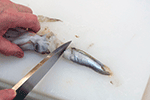 |
 |
|
| 3,Detach the liver part | 3,First remove cuttlebone from inside | |
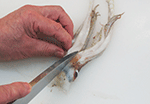 |
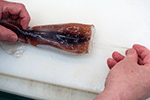 |
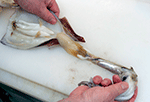 |
| 4,Point the white back of geso to the front and cut in the middle | 4,Pull out the thin transparent cuttlebone that remains inside | 4,Do not crush the squid ink, pull out the internal organs |
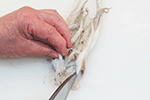 |
 |
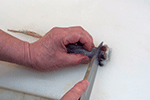 |
| 5,Insert two notches into the back of the eyeball | 5,The elongated transparent part in front is Japanese Common Squid's cuttlebone |
5,Put a cut of one line between the eyes on the front side |
 |
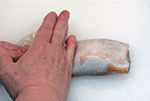 |
 |
| 6,Remove Japanese Common Squid's mouth called cephalopod beak | 6,Place the white back side up and the right hand on the narrow side of the triangle | 6,Open the incision, put the eyes out of the inside, and scoop it out with a kitchen knife |
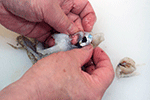 |
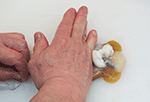 |
 |
| 7,Remove two eyeballs from the incision | 7,Move the right hand's belly toward the right and take out the remaining internal organs | 7,Push out cephalopod beak from inside |
 |
 |
 |
| 8,Scrape the hard part of the cartilage with a kitchen knife and prepare the shape | 8,Make it round slices at regular intervals | 8,State where cephalopod beak was taken out |
 |
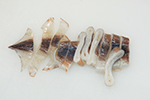 |
 |
| 9,Opening of geso ends | 9,State where round slices are cut off | 9,Status of geso not open |
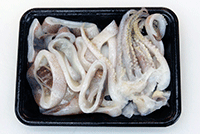  |
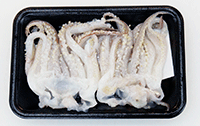 |
|
| The left is a combination of round slices and geso, the right is hot water frost's round slices | Items of geso | |
Next is the process of sashimi products and opening goods.
| Process of Japanese Common Squid sashimi products and opening goods | ||
|---|---|---|
 |
 |
 |
| 1,Cut along the top of the cuttlebone vertically | 1,Pull and peel squid fin | 1,Opening of Japanese Common Squid with skin |
 |
 |
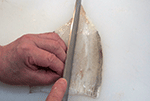 |
| 2,First remove cuttlebone from inside | 2,Put your finger between Japanese Common Squid's body and skin and make a gap there | 2,Remove the squid fin and shallowly cut across the fiber on the front side to decorative cut entirely |
 |
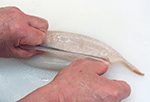 |
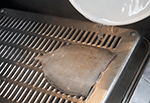 |
| 3,Do not crush the squid ink, pull out the internal organs | 3,Likewise, put your finger from the other side to make a gap | 3,Put a decorative cut on the surface, pour boiling water there, make it hot water frost |
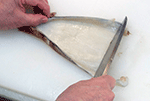 |
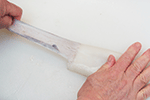 |
 |
4,Scrape the internal organs remaining inside with the cutting edge |
4,Pull and peel off one skin from the triangle side | 4,As a result of hot water frost, trace of decorative cut became prominent |
 |
 |
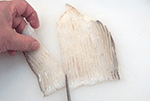 |
| 5,Products opened | 5,Separated state into body, leather, squid fin | 5、Not to remain wide, divide it into 1/3 and 2/3 |
 |
 |
 |
| 6,Pinch and peel squid ink adhering to the liver with fingers | 6,With reverse kitchen knife, cut out the side from which squid fin was removed | 6、Cut out the wider part at equal intervals, cut the length evenly and cut thinly |
 |
 |
 |
| 7,Squid liver product | 7,Scrape the rest of the internal organs remaining on the back side with the cutting edge | 7、In the same way, the narrower parts are slit equally spaced, and the lengths are also aligned and cut thinly |
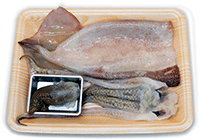 |
 |
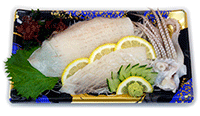 |
| Open · geso · liver combined products | Japanese common squid peeled skin for sashimi | Japanese Common Squid's skin hot water frost sashimi |
Recently nationwide, the number of shops sashimi the raw Japanese Common Squid introduced above is decreasing. This seems to be an idea that it is scary of anisakiasis with Japanese Common Squid as a host, so it only uses safe things that frozen and killed Anisakis once.
Such thing is not only Japanese Common Squid, mackerel and Sanma have the same tendency nationwide. I am saddened by the fact that such safety first thing, risk avoidance, etc. are occurring in the fish section of the whole country nation which was not thought in the past.
Removal of Anisakis should be safe if professionally cooked, but if your store has only technical levels that you can not trust, it is not only easy to avoid this, it is necessary to work through wisdom to survive. For example, if it is Japanese Common Squid, if you use the technique called hot water frost introduced this time, Anisakis will be completely killed, so if you do hot water frost not only with hot water frost with skin but also sashimi, the Anisakis problem can easily be overcome.
Moreover, in the case of Japanese Common Squid, there is the fact that it is more delicious to add heat, rather than eating raw as it is, especially the skin frost has a skin flavor by applying heat, It will be more tasty than without it.
Japanese Common Squid is commonly cheap compared with Spear squid, Swordtip squid, Bigfin reef squid, etc., in large quantities. Moreover, because somewhat a little bit harder to sashimi, there have been circumstances that have been seen in rank one step lower than other squid species so far. For example, in the West Japan area where Spear squid is often caught, it is usual that most people basically do not eat Japanese Common Squid as sashimi. So if you read an article of this month's issue such as a fish-loving very particular about fishs living in the western Japan area, if there are as many delicious squids as you like, you may think you do not have to do such a thing unknown.
However, if the reduction of catch of Japanese Common Squid continues for some time in the future, if the cheapness does not become cheap as in the past, there are not many options to choose squid like the western Japan area, and the areas where you often rely on Japanese Common Squid will be hard . In order to deal with this, we should have to endure this difficulty by increasing the degree of processing of less Japanese Common Squid and adding value.
I would like you to survive by using human wisdom for events that are inevitable by the human power of global environmental change.
| Please access the following URL if you want to secure using SSL. All pages in the site will be secure pages. |
| https://secure02.blue.shared-server.net/www.fish-food.co.jp/message english 3.2019.html |
An opinion and the communication are to iinfo@fish food times
Date of updating 1 Mar. 2019
